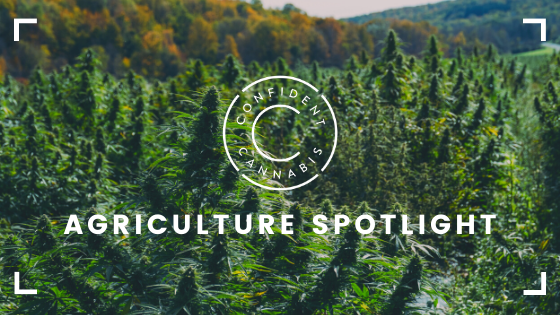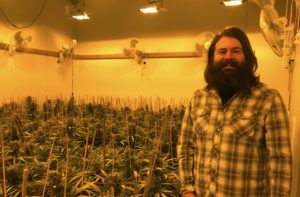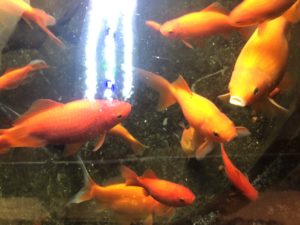Like many of today’s legally licensed cannabis farmers, Alex Noland started his career in the illicit weed market while in college. He would visit California farms to get more familiar with the process, taking what he learned back to his own small grow in Oklahoma, where he risked the jail sentence getting caught growing would bring. During that time, maintaining aquariums was another hobby of Alex’s that began with a single fish a friend gave him and grew from there. One day, shortly after graduating from college, Alex received a little piece of neighborly advice that fueled all of his future cannabis and aquarium endeavors.
“I went out front of my house to dump some dirty tank water,” he explained. “This 90-year-old lady who lived across the street was sitting on her porch watching everything going on, and she asked what I was doing. I told her dumping out dirty old fish water, and she asked if it was freshwater? I said yeah, and she says, dump it on the flowers; it will help them grow better!”
At first, he politely thanked her for a good idea, but later it dawned on him that this gardening tip could have huge implications for his cannabis farming.
“It hit me that I should grow aquaponically and immediately started researching methods,” Alex said.
About the time of this discovery, Alex was saving for a move out of Oklahoma. He took a 6-week drive around the country to decide where he wanted to start his adventures in cannabis farming.
“I always thought I would head to Northern California,” he said. “I visited Colorado, Montana, all the places that had medical programs. When I came to Oregon, I just fell in love.”
Alex has been growing in Estacada, Oregon, at the top of the Cascade Mountain Range for about seven years now. It took some time for Alex to find the right land and get the fish tanks up and running, he remembered.
“We produced weed but nothing substantial in the beginning,” Alex said. “My sister at the time was doing her Master’s Thesis on Soil Microbes, and we had a lot of phone conversations where she shared all of the research she was doing to help me come up with a handful of ways to make this work right.”
That’s when he was able to dial-in a custom hydroponics system that helped production take off right as the Oregon Recreational Bill went into law.
How An Aquaculture System Works
Living Things utilizes Aquaculture to create natural and organic flowers by cultivating freshwater under controlled conditions that integrate fish and aquatic plant farming. This method of growing cannabis creates an ecosystem between the fish living in the tank and the plant growing up top. The fish feed on the minerals in the roots of the plant that grow down into the water, and then the nutrient-rich fish water feeds the cannabis plant. Between the plant and fish is a layer of rocks and bio-filters.
“I actually do the cloning and everything right in this system,” Alex said. “I let the plants grow on top of rocks in the water until the roots are big enough to transfer the plant to a pot with organic soil.”
He explained that you could just leave the plants in the Aquaculture System to grow to full maturity, but Alex has found success with finishing out the harvest in his own organic soil mixture.
“I came up with a special soil blend to bio-enhance the plants; we mix it ourselves,” Alex said. “Then, when the plants are in the soil, we use an irrigation system to water them directly from the fish tanks to keep that cycle going.”
Utilizing the fresh fish water, Alex’s plants don’t need any fertilizer other than some compost tea he adds to the soil right as they go to flower.
“Fertilizers kill all the things living in the soil,” he said. “I have living soil, living water, living nutrients. When soil is alive, it starts to form this microcilia that is totally normal but looks a lot like mold. First time it happened, I freaked and thought my plants were growing mold. Later I learned this was a good sign of the life within my soil.”
Although Alex couldn’t count the number of fish in his facility at this point, he does still have one of the original fish tanks with some fish that are at least seven years old.
Dealing with Pests at an Indoor Grow Facility
Pests can be a huge issue, especially with a hydroponic system. Alex says it’s fascinating to watch how quickly something like a spider mite can grow once they get into a facility—multiplying by as much as 10,000 in a day. Alex and his team have strict cleanliness rules to stop infestations before they start.
“First thing I do is make sure everyone has work shoes and clothes,” he said. “There’s a big sign on the door that if you have been in contact with any nature or house plants, you cannot come inside. You have to shower, put on clean clothes, indoor shoes, always.”
Alex said that spraying plants with fish water also helps them grow immunity against pests, but the best way to fight bugs is just by having healthy plants.
“Pests can be good for your plant, too,” he said. “The plants that fight back actually test higher for THC when we go to harvest.”
Despite the pressures of keeping his controlled facility clean and bug-free, Alex says that he does prefer the indoor growing method because you get a lot more attempts to try and fail or try and succeed. Alex’s plants go to harvest about six times per year, barely giving him a break in between.
“My girlfriend has an outdoor grow nearby, and sometimes I’m jealous of her downtime after harvest,” Alex admitted.
Alex produces nine different strains at Living Things, which has expanded from the three or four strains he grew in the beginning for his medical patients. He does not currently do any processing on his land for extracts but is looking into the licensing and water rights to make that next step in the future.
Sharing Knowledge with Other Oregon Cannabis Farmers
Alex said that when he was first starting out, he got a lot of help from other indoor farmers as he worked through issues—but at a certain point, you reach the information that farmers don’t want to share. He even did his own consulting with farmers for a while to help them with things that worked for him (except for his special soil recipe), but most farmers tend to do things their own way in the end. The big exception is sharing knowledge with his girlfriend, who owns an outdoor farm in the area, then the lines of communication run freely.
“We work really well together,” Alex said. “We help each other on our farms, so she definitely knows all my trade secrets.”
The name, Living Things, speaks volumes not only to the plants that Alex grows but also the unique soil, living water, nutrients, and even goldfish living together in harmony.
“The one thing I would say about my system is that I’m recreating nature as naturally as possible with it,” Alex concluded.
Visit Living Things on Instagram.
You May Have Missed:





